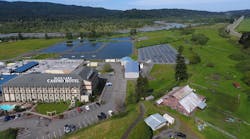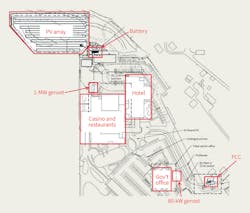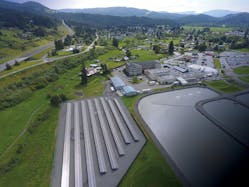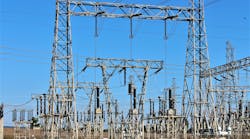When the Fukushima earthquake struck off the coast of Japan on April 11, 2011, a tsunami spread across the Pacific Ocean. Within an hour of the tsunami news broadcasts, thousands of residents in Humboldt County, California, U.S., evacuated to higher ground. The Blue Lake Rancheria Tribe is located 5 miles (8 km) inland from the Pacific Coast along Humboldt’s major east/west arterial, CA Highway 299, out of the tsunami zone. As people fled the coast, the Tribe’s facilities were inundated with more than 1000 vehicles and hundreds of panicked people. That event prompted the Tribe to take a fresh look at its resources and resilience.
Seven years later, with public/private partners, the Tribe has completed several projects that have substantially increased its resilience with low-carbon solutions. By developing within its strategic goal of zero-net-carbon emissions by 2030, the Tribe has implemented adaptation measures that reinforce its economic enterprises and reduce its carbon footprint.
The marquee project in its portfolio, to date, is a low-carbon, community-scale microgrid. The microgrid has reduced the Tribe’s energy costs by approximately $195,000 and reduced greenhouse gas (GHG) emissions by approximately 175 tons (159 tonnes) during the first year of partial operations and final commissioning activities. After final commissioning, the steady-state operation of the microgrid will achieve more than $200,000 in annual savings and reduce GHGs by more than 200 tons (181 tonnes) each year. The microgrid already has enabled a 10% increase in clean energy jobs and is designed to allow for expansion of solar and battery storage to increase economic and environmental benefits in the years to come.
Tenuous Energy Supplies
Humboldt County is rural and geographically isolated. An energy peninsula, the region connects to the larger Pacific Gas and Electric Co. (PG&E) grid by a 115-kV transmission loop that runs through wildfire country and is import-restricted to approximately 70 MW. The area is served by a single 10-inch (254-mm) natural gas line, within one of the most dangerous and active seismic zones in the U.S. The Cascadia Subduction Zone, Mendocino Fault, Gorda Plate, Pacific Plate and North American Plate all converge at the triple junction, directly offshore from the city of Eureka (about 20 miles [32 km] from the Tribe’s lands). Large earthquakes and tsunamis are a constant threat.
Diesel fuel is expensive; local retail costs are typically among the highest in the lower 48 states. Located ‘behind the Redwood curtain,’ landslides across the region’s two main arterials are frequent and can result in diesel supply constrictions. In 2017, the Tribe’s fuel station/convenience store diesel shipments were reduced by 60% for more than a week because of simultaneous landslides. Diesel fuel expense and supply chain vulnerabilities (in addition to GHG emissions) make diesel generators less reliable sources of back-up power locally.
Power interruptions and outages are frequent. Past outages have lasted from several days to several weeks and are an ongoing threat to the region. Adding to these vulnerabilities and threats, climate change has amplified local impacts. Drought now seems to be an annual occurrence or threat; storms (and resulting landslides) are more frequent and severe; wildfire is an imminent and constant danger almost year-round; and costs — including energy costs — are rising due to cascading effects of a warming planet.
Energy Lifeline Approach
In response to these impacts and factors, the Tribe has systematically invested in low-carbon resilience measures across its lifeline sectors: energy, water, food, communications/IT and transportation. The Tribe prioritized investments in energy because energy supports all the other sectors. The energy lifeline sector investment also supports tribal government activities and its economic enterprises, de-risking threats to continuity of operations in both business-as-usual and emergency situations. Onsite distributed generation enables the Tribe to take control of its energy future, reducing and leveling its energy costs.
The Tribe’s microgrid project was completed by an effective public private partnership led by the Schatz Energy Research Center at Humboldt State University. The project team was successful in securing $5 million in grant funding through the California Energy Commission (CEC) Electric Program Investment Charge (EPIC), which provided most of the funding for the approximately $6.6 million project.
Microgrid Design and Functionality
Broadly, the microgrid powers a six-building campus of the Tribe’s most critical infrastructure, including government offices, water and wastewater systems, lighting and surveillance, hotel, casino, restaurants, food storage and an event center, which doubles as a certified American Red Cross emergency shelter in times of need.
Onsite generation includes 420-kW solar PV, a 500-kW, 2-hour Tesla energy battery storage system, and two legacy diesel generation sets (1 MW and 80 kW). Onsite loads average about 450 kW, with a potential peak of 945 kW. The microgrid is connected to the larger PG&E grid at a point of common connection (PCC).
The project partnership was critical to the successful completion of the microgrid. The Schatz Energy Research Center was the prime contractor with the CEC and fulfilled the crucial roles of project management and integration engineering. As the regional utility partner, PG&E’s support of the microgrid concept at the CEC proposal stage — and throughout the three-year project — was essential. PG&E’s staff supported the Tribe’s purchase of the PG&E infrastructure onsite downstream of the PCC, and helped obtain California Public Utilities Commission approvals of this purchase. PG&E conducted interconnection design review and approval, assisted with value engineering and worked with the project team to complete four separate required agreements: Purchase and Sale Agreement, Special Facilities Installation Agreement (for PCC installation and change from secondary to primary customer status), Service Line Agreement, and Generating Facility Interconnection Agreement (multiple tariff).
Siemens and Idaho National Laboratory (INL) introduced the project concept to the Schatz Energy Research Center and the Tribe. The microgrid uses Siemens Microgrid Management System (MGMS) at its core, and Siemens engineers used the Spectrum 7 platform for this installation — the first of its kind at the community scale. Siemens and the project team worked closely with INL to conduct hardware-in-the-loop (HIL) testing that de-risked the system before installing and operating live onsite. The MGMS controller forecasts several key parameters and datasets to optimize economics and automate certain functions, such as load shed. INL provided HIL testing at its microgrid test lab to de-risk the system functions and to facilitate staff training on a real-world system. INL supported the project through three rounds of testing and several training sessions for engineering, facilities and IT staff.
Tesla energy battery storage is at the core of the microgrid’s ability to seamlessly transition from autonomously island to re-parallel with the utility grid. Tesla’s engineering staff supported system integration within the microgrid, and their storage technology resulted in the full use of the onsite solar generation.
If the larger grid goes down, the microgrid can detach from the larger grid and provide 100% of the campus power for as long as needed (with manual load shed available through the MGMS as needed). In business-as-usual circumstances, the microgrid uses only the solar array and battery storage as its generation platform, with some import from PG&E. The Tribe has two older, pre-existing diesel generators included in the microgrid that are used for generation redundancy. By including the generators, in the short term, the microgrid can use their emergency power, and the Tribe can cost-effectively de-prioritize their use over time — while not stranding the assets — in a methodical transition to decarbonized energy.
Lessons Learned
During design, deployment, testing and commissioning of the Tribe’s microgrid, recommendations emerged, as illustrated in this abbreviated list:
• It is essential to have an empowered lead integrator.
• Do not underestimate the integration challenges with communications protocols, vendor requirements, legacy equipment and equipment compatibility.
• Partners’ work should include scopes that support overall project integration, with the note that vendors may or may not work well together.
• Use advanced protection relays in the microgrid control system and ensure adequate relay programming time.
• Utility communication is fundamental to a microgrid
project; communicate early and often with the utility and respect interconnection and safety requirements.
• Account for network latency and control cycle times, especially when solar output is large relative to loads.
• HIL testing in a real-time digital simulation environment is critical to test design and operational integrity, find flaws and make changes prior to going live with the system.
• Use the HIL test phase to train staff on system and ensure operator redundancy.
• During live testing, use detailed test plans with contingencies for all failure modes.
• Include tradespeople with field experience at the micro-grid site on your project team.
• IT upgrades can disrupt communications between microgrid components and cause operational issues, therefore, coordination between IT and facilities is essential.
• Account for large reactive loads during design.
Economic Benefits
Specific economic benefits center around the Siemens MGMS’ ability to automate energy optimization and arbitrage, by using rate structure and weather and other forecasting data. The Tribe has reduced annual energy costs within the microgrid by approximately 30%, due to the durability and lifetime performance of solar PV paired with storage. The Tribe expects to maintain this leveled, predictable energy cost through the conservative, expected lifetime of the project. The microgrid enabled a 10% increase in clean energy jobs within related government divisions (facilities and IT). And the microgrid design and implementation allows for expansion — adding more solar PV, increasing battery storage and incorporating new energy-efficiency measures — that will increase economic benefits.
Energy Security Benefits
Solar PV paired with energy storage is among the most cost-effective and secure forms of energy available. The Tribe has an annual 365-day supply of fuel (solar). The microgrid itself is cybersecure, and because it can be islanded from PG&E’s system to provide emergency power, it helps lessen the cybersecurity risk to/from the larger grid. Within the microgrid are redundant sources of power. In addition to maximizing solar production and use, it includes generators to ensure multiple power generation pathways to counter volatility or equipment breakdowns. Operations and maintenance are manageable.
Resilience Benefits
Distributed energy resources are important for emergency preparedness and recovery in a disaster, especially in rural, sparsely populated areas with rugged terrain. If a Cascadia Subduction Zone earthquake strikes the majority of the Pacific Coast, the Humboldt County region will need to be self-sufficient, perhaps for several weeks or longer. The Tribe’s event center can double as an American Red Cross shelter, and because of its robust microgrid-enabled islanded, emergency power supplies, the Tribe’s campus of critical infrastructure could serve thousands of people with ‘life, health and safety’ services.
Follow On
The success of this microgrid project has spurred follow-on initiatives and replication. The Tribe is doubling the size of its Tesla Energy battery system with support from California’s Self Generation Incentive Program, estimated to be in operation in 2019. Also in progress is a solar + storage microgrid for the Tribe’s fuel station and convenience store complex, again led by the Schatz Energy Research Center as the integration engineering team and funded in part by an EPIC grant investment.
A new emergency community smart grid water system, which is planned for completion in 2019, will be connected to the microgrid for greater resilience in the water lifeline sector. And the Tribe is exploring a residential microgrid for low to moderate income tribal households that includes solar PV, battery storage and electric vehicle charging.
The Tribe’s Resilience Training and Innovation Center is a cooperative part of a regional ‘center for excellence’ for decarbonized energy and microgrid feasibility and implementation. As a wraparound program, the Tribe works closely with Humboldt State University and other community partners to foster STEM education, including regular tours and workshops at the microgrid site targeted to students in 7th grade and up, and research initiatives led by Humboldt State University undergraduate and graduate students.
Regionally, there are dozens of community- and facility-scale solar + storage projects in progress. The Schatz Energy Research Center, Redwood Coast Energy Authority, PG&E and other project partners have begun a $15 million microgrid for the regional California Redwood Coast Humboldt County airport. Like the microgrid at Blue Lake Rancheria, the airport project has a generation backbone of solar PV (2.5 MW) and Tesla energy battery storage (8 MWh), and builds on the regional expertise gained from projects hosted by the Tribe.
Real Results
The Blue Lake Rancheria Tribe’s microgrid was built to achieve economic and environmental goals and benefits, and is in alignment with the Tribe’s role as steward of the land. As all countries accelerate transitions to truly clean, decarbonized energy, microgrids are important options. Microgrids build on three pillars — transitioning to low carbon electricity, powering more things with electricity and improving energy efficiency — simultaneously.
Microgrids enable relatively fast deployment of distributed energy resources, improve grid cybersecurity and strengthen distribution-level systems. Microgrids can pair climate mitigation (GHG reductions) with adaptation for proven economic, social and environmental benefits. They allow leverage of infrastructure investments to achieve real resilience. ♦
Jana Ganion is the director of sustainability and government affairs at Blue Lake Rancheria.
Dave Carter is the managing research engineer at the Schatz Energy Research Center at Humboldt State University.
Sidebar: Functions of the Blue Lake Rancheria Microgrid
- Disconnect and reconnect to PG&E at will for planned islanding, using seamless
or break-before-make transitions - Automatic islanding and reconnect in unexpected PG&E outage
- Economic dispatch of solar + battery storage when grid connected (arbitrage)
- Import control (peak shaving)
- Export control (cap @ 100 kW)
- Inverter-only operation when islanded + PV/battery support load
- Controllable loads: five load-shed options predesigned, prioritized by outage
severity and manually activated through the MGMS - Automatic PV ramp-control curtailment in grid-connected and islanded modes
- Manual operation mode locks out external control of main breakers
Check out the May 2018 issue for more articles, news and commentary.





